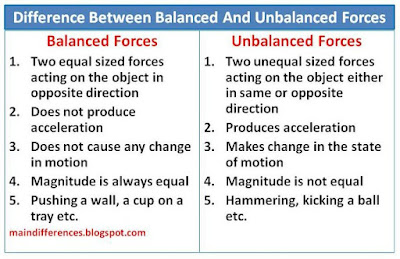Difference Between Balanced Forces And Unbalanced Forces
The major dissimilarities or difference between balanced and unbalanced forces can be highlighted as follows:
1. Introduction
Balanced Forces: Two equal sized forces acting on the object in opposing direction without making change in state of motion is called balanced forces.
Unbalanced Forces: Two unequal sized forces acting on the object either in same or opposing direction making change in state of motion is called unbalanced forces.
2. Production Of Acceleration
Balanced Forces: It does not produce acceleration
Unbalanced Forces: It produces acceleration
3. Cause
Balanced Force: It does not cause any change in motion, it means the object remains in its actual position (either moving or still)
Unbalanced Force: It causes change, it means still object may move, moving object may slow down, change direction or may stop.
4. Net Force
Balanced Forces: It does not change the state of motion, so net force is always zero
Unbalanced Forces: It makes change in the state of motion, so net force is always non zero
5. Magnitude
Balanced Forces: Magnitude of balanced forces is always equal
Unbalanced Forces: Magnitude of unbalanced is not equal
6. Acting Direction
Balanced Forces: This force acts in opposite direction with equal magnitude
Unbalanced Forces: It may act in same or opposite direction (pull or push) with unequal magnitude
7. Examples
Balanced Forces: Pushing a wall, a cup on a tray etc.
Unbalanced Forces: Hammering, kicking football, picking a cup from tray etc.





